The sun was shining when you launched your kayak this morning. But shortly after noon, it clouded over and the rain set in. You aren’t surprised: you are paddling the British Columbia coast not far south of Alaska, just off the most verdant rainforest on Earth.
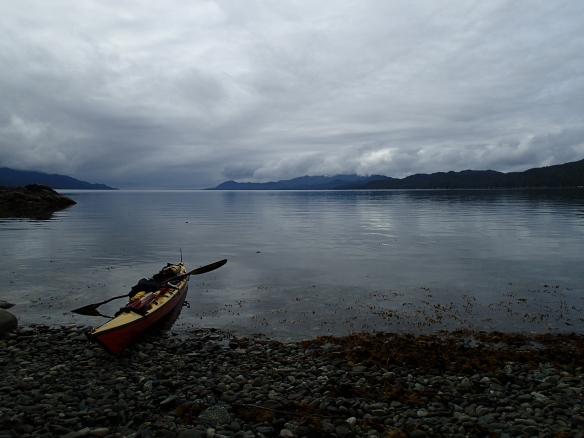 The fjord-like channel you’re travelling offers few landing spots, so it’s six in the evening before you ground the bow of your kayak as gently as possible on a cobble beach. Hours of rain have given you bathtub hands.
The fjord-like channel you’re travelling offers few landing spots, so it’s six in the evening before you ground the bow of your kayak as gently as possible on a cobble beach. Hours of rain have given you bathtub hands.
On the water, sealed into your boat by your sprayskirt and warmed by the constant pump of your arms, you were as untroubled by the rain as a swimming duck. But now you begin to feel the chill. You don’t panic, but you do set about making camp quickly and purposefully.
First, you portage all your cargo up the beach. Next, you carry the empty boat well above what you estimate will be the high tide line. Even so, you run a rope from the bow around a tree that isn’t going anywhere. This precaution has saved you from losing your kayak several times over the years.
Pulling another length of cord from your mesh bag of lines, you tie one end to a heavy stick, then lob it up and over a convenient tree branch. You repeat the process a little further away. Now you have high suspension points for the end eaves of your tarp. You run the corner lines off to bushes and driftwood logs. After thoughtfully inspecting the erected tarp for a moment, you raise one end of the ridge line a bit higher, then tie a weight to a grommet at the middle of one lower edge to form a drainage channel.
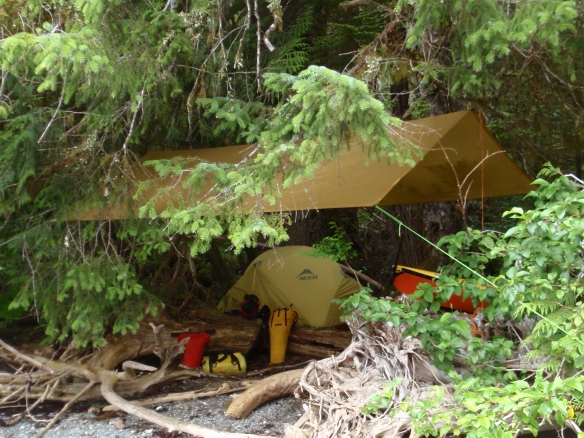
The interior canopy of your tent is already mildly damp from being packed with the wet fly. Still, you set it up under the tarp so the driving drops don’t saturate it completely. Once the fly is on, you move the assembled tent onto a tiny clear patch of moss at the forest’s edge.
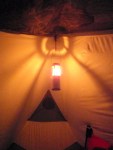 Crouching in the vestibule, you unfurl your sleeping pad in the inner tent and blow it up (a task always best completed before your belly is full of dinner). Next, you lay out your sleeping bag so it has time to loft to maximum warmth before bed. Lastly, you hang a candle lantern from the ceiling and light it. It’s not full dark, and you won’t be occupying the tent for hours, but its tiny flame will dry the canopy a bit and burn the damp out of the interior air.
Crouching in the vestibule, you unfurl your sleeping pad in the inner tent and blow it up (a task always best completed before your belly is full of dinner). Next, you lay out your sleeping bag so it has time to loft to maximum warmth before bed. Lastly, you hang a candle lantern from the ceiling and light it. It’s not full dark, and you won’t be occupying the tent for hours, but its tiny flame will dry the canopy a bit and burn the damp out of the interior air.
A quick hunt on the beach and upland produces deadfall tree limbs, thick and undecayed enough to retain dry cores. You could get dinner started faster on your Trangia stove, but tonight you need to rewarm your body outside as well as inside, so you will fire up your folding woodstove.
Safely back under the tarp, and shivering slightly now, you slip off your paddling jacket. Even though this shell is “breathable,” the thin layers of synthetic insulation underneath are clammy from hours of rain and exertion. You put on a fleece jacket directly over them; in a temporarily sunless world, your body heat is the only way to dry them. The trick is to add just enough additional insulation to offset the evaporative cooling as the underlayers steam off moisture.
With your folding saw, you trim the branches into stove-length billets, reminded yet again of Henry David Thoreau’s adage that anyone who cuts their own firewood is warmed by it twice: once in the cutting and once in the burning. With your hatchet, you split tinder. Previous experience has instilled in you the discipline to make a generous supply of small pieces, rather than smothering a nascent fire under wrist-thick chunks.
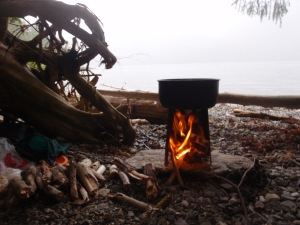 Though your folding stove has four sides, you assemble it with only three, leaving out the panel facing you. This gives you the fire-feeding airflow of a chimney, while radiating heat toward you like a fireplace. Slowly, you coax the flames to jump from small shims of wood to larger pieces, thawing your hands over them as they bloom.
Though your folding stove has four sides, you assemble it with only three, leaving out the panel facing you. This gives you the fire-feeding airflow of a chimney, while radiating heat toward you like a fireplace. Slowly, you coax the flames to jump from small shims of wood to larger pieces, thawing your hands over them as they bloom.
By the time the rice is cooked, the fire has warmed the flat slab of rock the stove stands on to chafing dish temperature. Just as you planned, this hot surface keeps the rice pot warm while you boil up the curry.
Beyond the tarp, the rain hisses on the sea like a frying pan (thanks to the rising tide, wavelets are washing the beach just a few metres from your kitchen). It’s mid-summer, season of the longest days, but the low cloud has brought an early twilight, and the damp air and Northern latitude combine to create a definite chill.
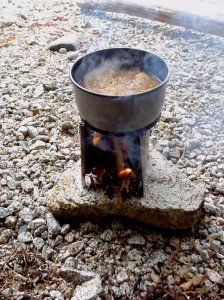 Under the tarp, the fire glows cheerfully in the semi-dark. You ladle out a generous first serving of curry, keeping the remainder warm on the heated rock. A sprinkled handful of unsalted cashews gives dinner the crunch that dried meals are often missing.
Under the tarp, the fire glows cheerfully in the semi-dark. You ladle out a generous first serving of curry, keeping the remainder warm on the heated rock. A sprinkled handful of unsalted cashews gives dinner the crunch that dried meals are often missing.
As the dish water heats on the stove, you update your journal (it’s dark enough now that you need your headlamp.) Then, with the dishes and food bags safely stowed in the kayak, you follow the welcoming beacon of the candle lantern to your tent.
Inside, it’s definitely drier and feels several degrees warmer. You think, not for the first time, that one of these days you really must remember to measure the difference with your watch’s thermometer.
Your now-dry paddling underlayers go into your pillow stuffsack as padding (it will be so nice not to have to pull on clammy clothes in the morning.) You slip into a cotton T shirt and underwear, marvellously pleasant against the skin after the plastic bag feel of synthetic fabrics. Like your down sleeping bag, the cotton clothing travels in a fully submersible drybag, and in rainy weather is taken out nowhere but inside the tent. (Like most campers, you prefer sunny weather. But you take pride in having the skills to operate safely in the rain, for days on end if necessary.)
Back in the city, you usually need to read to silence the chattering monkey of your mind before falling asleep. But now, relaxed by exercise, thawed by fire and hot food, and cuddled in the warm embrace of the bag, you drift off in minutes, with the rain drops on the tent roof as a lullaby.

Well done. Brings it to life.
LikeLike
A thoughtful, lovely and vivid presentation of the camping experience. At the simplest level – a primer; at the uppermost – a song.
Thanks Philip.
LikeLike